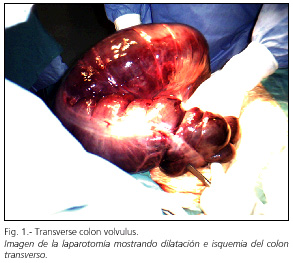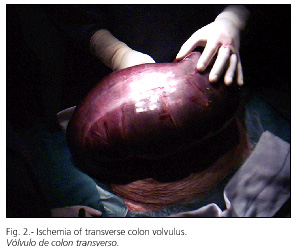My SciELO
Services on Demand
Journal
Article
Indicators
-
 Cited by SciELO
Cited by SciELO -
 Access statistics
Access statistics
Related links
-
 Cited by Google
Cited by Google -
 Similars in
SciELO
Similars in
SciELO -
 Similars in Google
Similars in Google
Share
Revista Española de Enfermedades Digestivas
Print version ISSN 1130-0108
Rev. esp. enferm. dig. vol.97 n.12 Madrid Dec. 2005
| PICTURES IN DIGESTIVE PATHOLOGY |
Intestinal occlusion secondary to transverse colon volvulus
M. C. Casamayor Franco, J. A. Gracia Solanas, C. Artigas Marco, M. A. Bielsa Rodrigo and M. Martínez Díez
Service of General Surgery and Digestive "B". Hospital Clínico Universitario Lozano Blesa. Zaragoza, Spain
 |
Transverse colon volvulus is an uncommon disease (1-5%) (1,2). It is caused by a short mesentery associated with a normal fixation at the hepatic and splenic angles (1). A 34-year-old woman previously diagnosed with neurofibromatosis visited an emergency room due to 4-day-standing abdominal distension as a result of intestinal occlusion. Laboratory tests showed leukocytosis and neutrophilia, metabolic acidosis, and abnormal coagulation. A plain abdominal Rx demonstrated a greatly dilated large bowel, and a volvulus was suspected (Fig. 1). After a failed attempt at endoscopic devolvulation, the patient underwent emergency surgery, during which a segmental colonic resection with end-to-end anastomosis was needed (Fig. 2). The patient had a second procedure for anastomotic dehiscence and diffuse peritonitis the 10th postoperative day, needing a proximal colostomy and closure of the distal stump. As predisposing factors, anatomical and congenital alterations (lax colonic angles and mesentery fixations), physiological factors (chronic constipation results in colon elongation and motility disorders, commonly associated with mental defective patients), and distal intestinal occlusion (sigma volvulus, pregnancy, carcinoma, surgical adhesions) must be considered (1,3). Associations with Chilaiditi's syndrome and Hirschsprung's disease have been described (2). Under normal circumstances, volvulus of the transverse colon has an acute or subacute clinical presentation. Sometimes vomiting appears early from duodenal-jejunal compression (1). Endoscopic devolvulation is not recommended because of a high percentage of gangrene in this type of volvulus (16%) (3). This is why surgery is the best treatment, with colonic resection plus primary anastomosis or colostomy and mucosal fistula being primarily indicated (1-5).
REFERENCES
1. Medina V, Alarcó A, Meneses M, Gil D, Márquez MA, Afonso JJ, et al. Vólvulo de colon transverso: una causa poco frecuente de obstrucción intestinal. Rev Esp Enferm Dig 1994; 86 (3): 683-5.
2. Plorde J, Rarker E. Transverse colon volvulus and associated Chilaiditi's syndrome: case report and literature review. Am J Gastroenterol 1996; 91 (12): 2613-6.
3. Echenique M, Amondaraín JA. Vólvulos de intestino grueso. Rev Esp Enferm Dig 2002; 94 (4): 201-5.
4. Khoda J, Sebbag G, Lantzberg L. Volvulus of the transverse colon. Apropos of three cases. Ann Chir 1993; 47 (5): 451-4.
5. Ortiz H, Romeo I, Miguel M. Vólvulo de colon transverso. Aportación de dos nuevos casos y revisión de la bibliografía. Cir Esp 1986; 40 (5): 1150-4.











 text in
text in 



